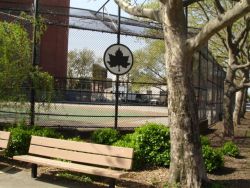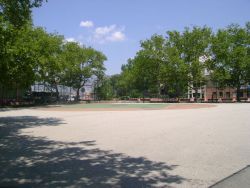Harold Ickes Playground
Harold Ickes Playground
What was here before?
This neighborhood of Red Hook was settled by the Dutch in 1636. The area was originally called Roode Hoek for the reddish color of the soil and the distinctive shape of the land.
Two hundred years after the arrival of the first settlers, Red Hook’s marshy land remained rural and undeveloped until the construction of the Atlantic Basin in the spurred growth. The Atlantic Dock Company developed piers in the Atlantic Basin, and William Beard, a railroad contractor, built up wharves in nearby Erie Basin. The peninsula quickly became one of the busiest shipping centers in the United States. By the beginning of the Civil War, ships from all over the world docked at Red Hook. At the turn of the 20th century, the neighborhood was still bustling, and it prospered well into the 1930s and 1940s, when the basin employed over 7,000 people.
How did this site become a playground?
Between 1940 and 1945, the City acquired this property for the Brooklyn-Battery Tunnel (now known as the Hugh L. Carey Tunnel). The tunnel was built after a bitter dispute involving Parks Commissioner Robert Moses and several citizen groups. Moses wanted to build a Brooklyn-Battery Bridge but many citizens objected, and the plan was rejected by President Roosevelt who instructed the Army to refuse permits for the bridge. Plans for a tunnel were accepted instead, preserving the Battery. Construction on the tunnel began in 1940, but was later delayed due to World War II, and the tunnel was not completed until 1950. A ventilation shaft for the tunnel occupies a corner of this playground.
In 2024, this became Red Hook’s first BMX and skate park complete with a multipurpose playground with climbing boulders and free space for parkour activities.
Who is this playground named for?
Harold LeClair Ickes (1874-1952) served as Secretary of the Interior in President Roosevelt’s famed New Deal Cabinet.
Ickes was born in Frankstown Township, Pennsylvania. He attended the University of Chicago, eventually becoming a political writer for the Chicago Daily Record in 1897. He graduated from the University of Chicago Law School in 1907 and established himself as an activist, often taking civil liberties cases for no pay.
Originally appointed to President Roosevelt’s cabinet position only after others refused, Ickes quickly proved himself a valuable member. To stimulate the economy, the government spent billions of dollars on public works projects, most of which Ickes controlled. Under his direction, the government built parks, highways, municipal buildings, and utilities such as the Hoover Dam. An ardent conservationist, Ickes believed parks should be used only for recreation, and he fought to expand Olympic National Park and against the efforts of the Catholic Church to build in the Grand Canyon.
Ickes had a hot temper, and when disputes arose, he often threatened to resign. Roosevelt considered him invaluable and refused to accept the resignation each time. When Roosevelt died in 1945 and Harry Truman replaced him, Ickes and Truman feuded frequently. In 1946, Ickes pulled his normal bluff and submitted his resignation, Truman happily accepted, ending Ickes’s career in the Cabinet. Ickes died on February 3, 1952 in Washington, D.C.
Check out your park's Vital Signs
Clean & Safe
Green & Resilient
Empowered & Engaged Users
Share your feedback or learn more about how this park is part of a
Vital Park System



